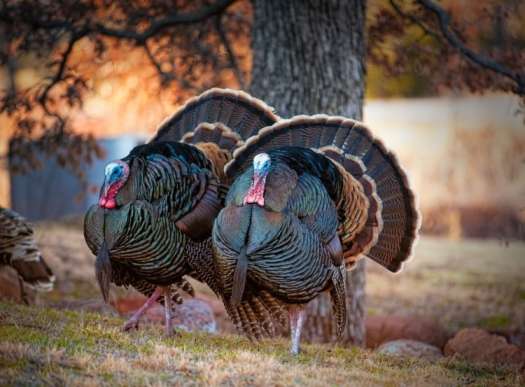Wild turkey is attractive native North American birds that almost disappeared in the early 20th century but a significant comeback. Today these royal birds can be seen in vast areas of the United States and parts of Canada and Mexico. For wildlife enthusiasts for birds photographers and curious nature lovers facing wild turkey in their natural habitat offers a thrilling glimpse in the wild heart of America.
These influential birds play the weight of up to 24 pounds and the specific fan-shaped tail and colorful vital-in the flocks through the parts fields and rapid suburban areas. This comprehensive guide will help you find out where and how to spot wild turkey roaming freely in North America.
Understanding Wild Turkey Habitat Preferences

Wild turkeys thrive in diverse scenarios that provide a mixture of forest areas and open areas. They prefer accommodation with mature trees for walking and nesting nests with clearing where they can forest for food. Oak-hikers are particularly attractive for one turkey as acorn and nuts become an important part of their diet.
These birds favor places with reliable water sources nearby as they need to drink daily. The ideal Turkey is involved in the residence which is called biologists "edge habitat" - between different ecosystems types where forests meet grasslands or agricultural areas. These edge environments provide both predators and covers from open areas to feed and intercourse displays. Wild turkeys are adaptable birds, expanding their limits as conservation efforts have allowed their population to recover in the early 1900s.
Prime Locations in the Eastern United States
Eastern United States hosts the largest population of eastern wild turkey; a sub-species is distinguished by its chestnut-brown tail tips. The Ellagheni National Forest of Pennsylvania represents one of the major locations for Turkish Spotting with its broad hard work with the ideal residence.
Main's North Woods and New York's Edirondac Mountains also support healthy turkey population, especially during spring intercourse when men engage in wide performances. Some of the highest Turkish density of the country have been claimed in the southern states such as Georgia Alabama and Mississippi.
The Epalachian mountain spread from Georgia to Main built a continuous corridor of Turkey's residence offering opportunities to see excellent viewing Great Smoki Mountain National Park. For wildlife photographers Shenandoa National Park of Virginia provides stunning backgrounds to capture these birds in their natural environment especially with skyline drive during morning time.
Western Turkey Spotting Opportunities
The Western United States is home to many Turkish sub -species, including merium Rio Grande and wild turkey of Gold. In areas such as Oak Woodland, California especially Los Padress National Forest and Sierra Nevada foothills support the healthy population of wild turkey.
Colorado and Arizona have Turkey in Merium which are adapted to the Pondrosa pine forests and mountainous grasslands of these regions. Oregon and Washington states offer rapidly abundant turkey view opportunities especially in their eastern parts where mixed forest and agricultural land makes ideal Turkey residence.
The Black Hills of South Dakota represents another western Turkish Hotspot, in which the unique ecosystem of the region supports the rich population of wild turkey of Merium
Midwestern Turkey Territories
After successful reproduction efforts, the midwest has become a stronghold for wild turkey. Missouri stands as a special success story, with its conservation department leading groundbreaking Turkish restoration projects that have served as models for other states. Missouri Ozarks now supports one of the densest turkey populations in the country, with the bird region's Ok-Hikari forests.
The flowless region of visconsin, which is characterized by its unrelated topography of steep lines and deep valleys, provides excellent turkey habitat and opportunities for viewing. Similarly, the South East Blufflands of Minnesota along with the corridor of the Mississippi River host the abundant turkey population.
The river values of the Iowa offer to see the Woodlots prime turkey's viewing, especially in the spring when men can be stretched and displayed in the edges of the agricultural area adjacent to the wooden stand.
Read more:- Globetrotter's Paradise: Unveiling Worldly Wonders in the USA
Southern Turkey Hotspots
The south -east United States represents the ancestral stronghold of the wild turkey and offers some best viewing opportunities. Ossola Wild Türkiye, Florida, is not found anywhere else in the world, inhabited in Pameto and Pine Flatwoods of the peninsula. The Red Hills region spread to the Florida-Jorgia border is famous among wildlife enthusiastic people for its extraordinaryly managed properties that support the extraordinary turkey density.
Texas Rio Grande claims the huge population of Wild Turkey, especially in the Edwards Plateau and the South Texas brush country, where their specific lighter dyeing helps to mix them in a more dry environment. Louisiana's Achafalaya Basin, the largest wetland in the United States, provides unique opportunities to the eastern wild turkey to adapt to marshy houses.
In the entire south, managed pine plantations are added with hardwood draw and create the ideal mosque of the residence in agricultural fields, where Turkey can be regularly seen regularly during the morning and late afternoon hours.
.webp)